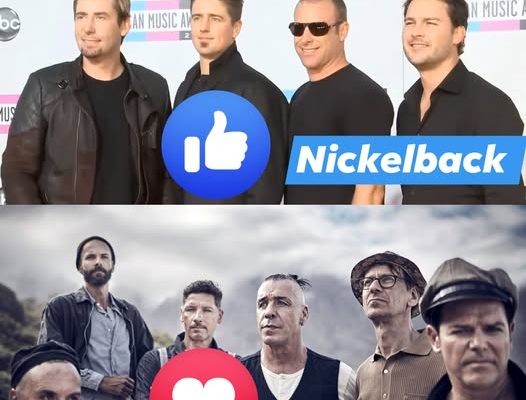The debate over which band truly represents the spirit of rock and metal has long been fueled by fans, critics, and the wider music community. Two names that have constantly sparked conversation from opposite ends of the spectrum are Rammstein and Nickelback. While Rammstein has cultivated an image of intensity, industrial ferocity, and unapologetic shock value, Nickelback has carved a mainstream path, delivering polished rock anthems that simultaneously dominate radio waves and divide audiences. To set these two giants against each other is to explore two very different worlds of rock music, two cultures that speak to entirely distinct audiences, yet intersect within the broader narrative of what defines rock and metal listening today.
Rammstein emerged from Germany in the mid-1990s, bursting onto the international scene with a brand of industrial metal that combined crushing riffs, martial rhythms, and theatrical performances. Their music, laced with provocative themes, German lyrics, and an unflinching exploration of taboo subjects, challenged the boundaries of both metal and performance art. A Rammstein concert is not just a live show—it’s an experience, where fire, pyrotechnics, and shock visuals become an extension of their sound. Fans hail Rammstein as authentic torchbearers of metal because they embody rebellion, darkness, and spectacle in a way that aligns with the roots of heavy music’s countercultural spirit. For these listeners, Rammstein is more than a band—they are a movement that channels the very essence of industrial and metal’s raw energy.
On the other side of the spectrum lies Nickelback, the Canadian rock band that dominated the early 2000s with chart-topping hits like “How You Remind Me” and “Photograph.” While often criticized for their formulaic approach, Nickelback undeniably tapped into something powerful in the mainstream market. Their songs blend post-grunge grit with arena-ready choruses, crafting a sound that appealed to millions worldwide. To their supporters, Nickelback represents accessibility: rock music that is digestible, melodic, and capable of crossing over into popular culture without alienating casual listeners. The band’s commercial success is staggering, with over 50 million albums sold worldwide and consistent chart presence over two decades. For many, Nickelback defined what mainstream rock sounded like in the 21st century.
The question then becomes: who truly defines rock and metal listening? Is it Rammstein, with their uncompromising vision, or Nickelback, with their mass appeal and cultural ubiquity? The answer depends heavily on how one views the role of music itself.
To begin with, authenticity is often the measure by which rock and metal fans judge a band’s significance. Rammstein’s authenticity is unquestionable. They remain loyal to their native German language despite global fame, ensuring their music feels grounded in cultural identity rather than engineered for broad consumption. Their lyrics are unapologetically dark, provocative, and at times controversial, refusing to bow to political correctness or commercial expectations. For purists, this makes them truer representatives of metal’s ethos: rebellion, provocation, and artistic freedom. Their live shows reinforce this image, not merely as entertainment but as ritualized chaos, pushing boundaries of what audiences expect.
Nickelback, in contrast, is often criticized for lacking this sense of authenticity. Detractors accuse them of churning out formulaic songs designed for radio play, recycling themes of love, heartbreak, and shallow hedonism. Their polished production and reliance on accessible song structures make them the antithesis of underground authenticity. Yet, one could argue that Nickelback’s authenticity lies in their willingness to embrace being populist. They never pretended to be avant-garde or revolutionary. Instead, they unapologetically chased the mainstream, and in doing so, became one of the most successful rock acts of their era. For listeners who measure a band’s impact by reach and recognition, Nickelback cannot be dismissed.
Another aspect of this showdown is cultural influence. Rammstein has influenced countless metal bands with their industrial sound and stage theatrics. They demonstrated that non-English lyrics could resonate globally in a genre often dominated by Anglo-American acts, proving that metal’s power transcends language. Their iconic songs like “Du Hast” have become staples in metal history, often cited as gateway tracks for fans entering the industrial subgenre. Culturally, Rammstein symbolizes resistance to conformity, artistic audacity, and the global reach of heavy music.
Nickelback’s cultural influence, however, comes from ubiquity. For better or worse, they became the face of early 2000s mainstream rock. Their hits were inescapable, playing in bars, car radios, sports arenas, and high school dances. This omnipresence made them a cultural touchstone—even if much of the conversation surrounding them was ridicule. Nickelback became the butt of countless jokes, often cited as the “worst band in the world” by critics and internet culture. Yet paradoxically, this mockery only amplified their presence in the cultural conversation. While Rammstein represents underground defiance, Nickelback represents mainstream saturation. Both, in their own ways, defined eras and perceptions of rock.
The fanbases of these bands further highlight the contrast. Rammstein fans are fiercely loyal, drawn to the band’s uncompromising vision and theatrical mystique. For them, attending a concert is akin to joining a ritualistic celebration of fire, sound, and rebellion. Their identity as fans often ties into valuing artistic boldness and embracing the darker side of human expression. Nickelback fans, on the other hand, are broader and less defined by subcultural identity. They are casual listeners who enjoy catchy choruses, relatable lyrics, and the band’s consistency in delivering familiar rock sounds. While they may not form as tight-knit or passionate a community as Rammstein fans, they represent the sheer scale of mass appeal.
Critics and audiences often pit these bands against each other as symbols of what rock and metal should—or should not—be. To some, Rammstein embodies the essence of what keeps metal alive: dangerous, uncompromising, and unafraid to disturb. Nickelback, by contrast, is seen as a dilution of rock, a safe product designed to sell records without pushing boundaries. But this binary overlooks the reality that both bands serve important roles. Rock and metal have always existed as a spectrum, ranging from extreme underground subgenres to mainstream accessibility. Rammstein and Nickelback represent two poles of this spectrum. Without the accessibility of bands like Nickelback, rock might lose its mainstream foothold; without the uncompromising artistry of bands like Rammstein, rock might lose its edge and relevance to those seeking rebellion.
In the ultimate showdown, it may not be about who defines rock and metal listening more, but how both coexist to shape the landscape. Rammstein defines the experience for listeners who crave intensity, spectacle, and the darker corners of artistic expression. Nickelback defines it for listeners who want relatable, singable rock songs that play well on the radio and in arenas. Both perspectives are valid, and both reflect the diversity that has always been central to rock’s evolution.
Ultimately, the showdown between Rammstein and Nickelback highlights a larger truth: rock and metal cannot be defined by a single band, style, or philosophy. They thrive precisely because of their plurality—because they can hold within them the theatrical firestorms of Rammstein and the radio-ready choruses of Nickelback. For fans, the choice between the two says more about personal identity and values than about absolute truth. In the end, the debate itself keeps the spirit of rock alive, reminding us that the genre remains as contested, passionate, and alive as ever.



